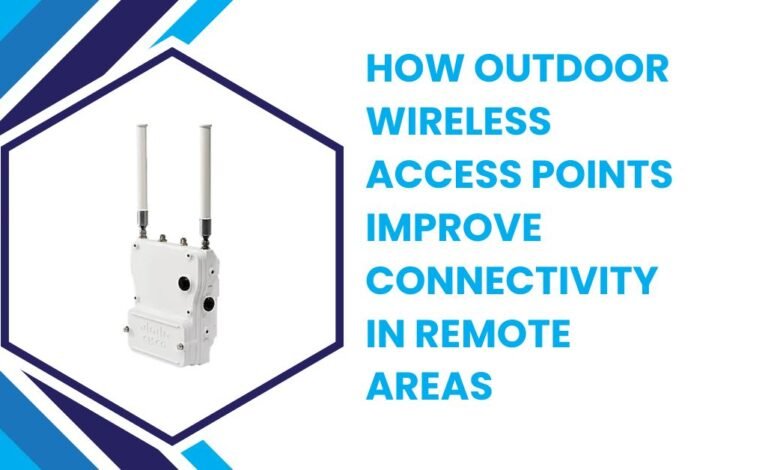How Outdoor Wireless Access Points Improve Connectivity in Remote Areas
Outdoor Wireless Access Points

Outdoor wireless access points have become increasingly important as more people seek reliable internet connections in remote areas. Whether it’s a rural town, a large farm, or a distant industrial site, having internet access is essential for communication, business, and even daily life. In these locations, the typical indoor access points might not be sufficient, leading to weak signals or complete dead zones. Outdoor wireless access points offer a solution that brings strong connectivity to areas where it was previously difficult to achieve. This blog will explore how outdoor wireless access points can improve connectivity in remote areas, and why they are such a vital tool for ensuring people stay connected.
Why Are Outdoor Wireless Access Points Important?
Outdoor wireless access points are specifically designed to withstand environmental challenges and provide strong, consistent internet signals across larger, open areas. In remote locations, access to reliable internet can be problematic due to the lack of infrastructure, such as cell towers and cable internet lines. However, outdoor wireless access points are equipped to handle these challenges and extend the range of internet connectivity.
Unlike indoor access points that are designed for smaller, enclosed spaces, outdoor access points are built to cover wider areas and endure weather elements like rain, snow, and extreme temperatures. This makes them the ideal solution for locations where other types of access points would fail. In rural communities, for instance, people can access high-speed internet from their homes or farms, allowing them to work, communicate, and even entertain themselves without interruptions. For businesses in remote areas, such as agricultural sites or outdoor venues, outdoor access points ensure smooth communication and data management across vast distances.
Note – For reliable Outdoor Wireless Access Points, look no further than Soyuztech Trading. Enhance connectivity in remote areas with high-quality solutions designed to keep everyone connected. Get in touch with Soyuztech Trading today to learn more about improving network performance with advanced wireless technology.
The Benefits of Outdoor Wireless Access Points in Remote Areas
Outdoor wireless access points offer several key benefits that make them an excellent choice for improving connectivity in remote areas. One of the main advantages is the extended range that these access points provide. They can cover large areas, such as fields, parks, and even entire villages, with a single device. This wide coverage ensures that people and devices stay connected no matter where they are within the range of the access point.
Another benefit of outdoor wireless access points is their durability. Since they are built for outdoor use, these devices are weather-resistant and can function in extreme conditions without losing signal quality. Whether it’s a heavy downpour or a scorching summer day, outdoor access points will continue to provide a stable internet connection. For remote areas where harsh weather is common, this durability is critical for ensuring constant communication and access to essential services.
Lastly, outdoor wireless access points are often scalable. This means that if a remote area requires more coverage, multiple access points can be added to create a larger network. This scalability is particularly useful for large farms, outdoor events, or rural communities that might need internet access across vast areas. By installing additional access points, the network can be expanded to cover as much ground as necessary.

How Outdoor Wireless Access Points Work
Outdoor wireless access points function by connecting to a main internet source, such as a modem, and broadcasting the internet signal across a large area. These devices use high-powered antennas that send signals over greater distances compared to indoor access points. They also come with advanced features such as mesh networking, which allows multiple access points to communicate with each other and provide seamless coverage over larger areas.
Mesh networking is especially important in remote areas where obstacles like hills or buildings might block signals from a single access point. With mesh technology, multiple outdoor wireless access points can work together to ensure that there are no dead spots in the network. If one access point experiences a problem, the others will compensate by redirecting the signal, keeping the network stable and functional.
Moreover, outdoor wireless access points can be configured to work on different frequency bands, such as 2.4 GHz and 5 GHz. This flexibility allows them to handle various types of devices and data loads. In a remote community, for example, some users might need the 2.4 GHz band for long-range, lower-speed tasks like browsing the web, while others may require the 5 GHz band for high-speed activities like video streaming or online gaming. The ability to switch between these frequency bands makes outdoor wireless access points versatile and suitable for different use cases.
Key Considerations When Installing Outdoor Wireless Access Points in Remote Areas
Before installing outdoor wireless access points in remote areas, there are several important factors to consider. First, it is crucial to assess the specific needs of the area. Understanding the size of the area that needs coverage, the number of users, and the types of activities that will require internet access are all key in selecting the right outdoor access points. Some areas might only need a small number of access points, while others may require a large network with multiple devices working together.
Second, it’s important to think about the placement of the access points. Outdoor wireless access points work best when they are installed in locations where they can broadcast signals without obstruction. This might mean placing them on rooftops, poles, or other high points where trees, buildings, or terrain won’t block the signal. Additionally, it’s important to consider the power supply for the access points. In very remote areas, solar-powered access points or access points with battery backups might be necessary to ensure uninterrupted service.
Finally, security should be a top priority when installing outdoor wireless access points. Since these devices are located in open areas, they are more vulnerable to unauthorized access or tampering. It is essential to set up strong encryption protocols and passwords to protect the network from potential hackers. Regularly updating the firmware and monitoring the network for any unusual activity will also help maintain the security and integrity of the connection.
Real-World Examples of Outdoor Wireless Access Points in Use
There are many real-world examples of outdoor wireless access points being used to improve connectivity in remote areas. One common application is in rural farming communities where access to high-speed internet is limited. By installing outdoor wireless access points across the fields and barns, farmers can monitor livestock, manage irrigation systems, and even conduct business operations from their homes or tractors. The ability to stay connected allows for more efficient farm management and reduces the need for time-consuming trips to distant towns for internet access.
Another example can be seen in outdoor event spaces like music festivals or large sports venues. These areas often attract thousands of visitors, and providing reliable internet access is crucial for everything from ticket scanning to social media sharing. Outdoor wireless access points are deployed across the venue to ensure that attendees can stay connected no matter where they are. Even in remote locations with little existing infrastructure, these access points make it possible to set up temporary networks that can handle large crowds.
Similarly, outdoor wireless access points are used in remote industrial sites such as oil rigs or mining operations. These sites often span large areas and are located far from traditional internet infrastructure. By using outdoor wireless access points, workers can communicate with each other, monitor machinery, and access real-time data without being limited by distance or poor connectivity.
Conclusion: The Future of Connectivity in Remote Areas
In conclusion, outdoor wireless access points play a crucial role in improving connectivity in remote areas. They provide a reliable, durable, and scalable solution that brings high-speed internet to places where it was previously difficult to achieve. Whether in rural communities, large outdoor venues, or industrial sites, outdoor wireless access points ensure that people and devices can stay connected over long distances and through harsh environmental conditions.
As technology continues to advance, outdoor wireless access points will become even more important for bridging the digital divide and bringing internet access to everyone, regardless of their location. For remote areas that rely on connectivity for work, communication, or everyday life, these devices are a game-changer, offering the possibility of staying connected in ways that were once impossible.
For more insightful articles related to this topic, feel free to visit toastul.com



